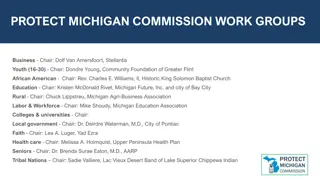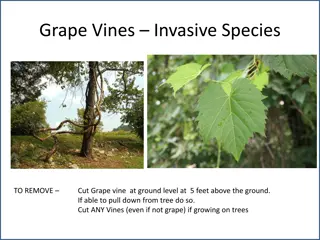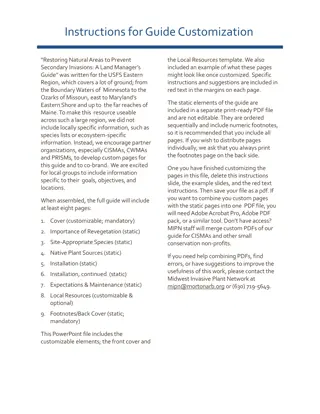Understanding Invasive Species in Northwest Michigan
Explore the impact of invasive species in Northwest Michigan through images and data on habitat support for butterfly and moth species, the transition of non-native plants to becoming native, and the definition of what makes a species invasive. Learn about the threats posed by non-native species and the efforts to control their spread, highlighting the importance of preserving native habitats.
Download Presentation

Please find below an Image/Link to download the presentation.
The content on the website is provided AS IS for your information and personal use only. It may not be sold, licensed, or shared on other websites without obtaining consent from the author. Download presentation by click this link. If you encounter any issues during the download, it is possible that the publisher has removed the file from their server.
E N D
Presentation Transcript
Invasive Species in Northwest Michigan
Natures Vast, Unseen World Northern spicebush swallowtail. Hosts: spicebush, sassafras. Lisa Brown Double-toothed prominent (Nerice bidentata) on an elm leaf. Pandorus sphinx moth (Eumorpha pandorus) on a Virginia creeper at Kids Creek Park. Carol Groves
Natures Vast, Unseen World Woody Plants Ranked by Ability to Support Butterfly/Moth Species Common Name Genus Species Supported oak Quercus 534 willow Salix 456 cherry, plum Prunus 456 birch Betula 413 elm Ulmus 213 pine Pinus 203 chestnut Castanea 125 Source: Tallamy, Doug. Bringing Nature Home. Timber Press, 2007.
How Long Until Non-Native Becomes Native? How long does change take? Hosting Capacity of Alien Plants Introduced to North America Plant Species Herbivores Supported in Homeland Herbivores Supported in North America Years Since Introduction to North America Black sally 48 species 1 species 100 Melaleuca tree 409 species 8 species 120 Indian fig cactus 16 species 0 species 250 Invasive phragmites 170 species 5 species 300+ Invasive Phragmites Source: Tallamy, Doug. Bringing Nature Home. Timber Press, 2007.
Whats Invasive? Few natural predators Massive seed production Non-native Invasive honeysuckle Jake Hendee Native monarch caterpillar eating native milkweed leaf Agriculture and Agri-Food Canada Archive, Agriculture and Agri-Food Canada, Bugwood.org Purple loosestrife beetle introduced for biocontrol Wolfgang Meinhart Frankenstoen, Bugwood.org
Whats Invasive? Formal definition a non-native species that harms people, the environment, or the economy. J rg Hempel Ellen Jacquert Saffron Blaze Source: Michigan Natural Features Inventory Environmental harm a natural area consisting mostly of one or a combination of introduced plants that provide minimal habitat value.
How Do They Get Here? Imported accidentally Imported for gardens Invasive Phragmites John M. Randall, The Nature Conservancy, Bugwood.org Planted to manage soil erosion Buckthorns Mark Lindsay Imported for food or medicine Autumn olive Garlic Mustard Grand Traverse Regional Land Conservancy
Japanese knotweed Polygonum cuspidatum (Fallopia japonica) Native to Asia Introduced as an ornamental Illegal in Michigan Problems: Traditional uses: food, medicine. Displaces native species Buyabetterhome.co.uk Difficult to control Can damage property Bradley Kriekhaus, USFS 10-12 feet tall Often called Michigan bamboo Randy Westrbooks, USGS
Garlic Mustard Alliaria petiolata Native to Eurasia Introduced as a food source Problems: Displaces Natives Competes with tree seedlings Unpalatable to most native herbivores Disposal options: Chris Evans Traditional uses: food, papermaking, animal feed Find a use Dumpster Tarping Katie Grzesiak
Invasive Phragmites Phragmites australis Native to Europe Introduced accidentally Problems: Displaces native plants Decreased property values Increased fire risk Can reach up to 15 feet tall There is a native phragmites
Oriental bittersweet Celastrus orbiculatus Native to Asia Introduced as an ornamental Problems: Out-competes native American bittersweet Shades out trees it climbs on Max Williamson Traditional uses: native and introduced versions both used in fall crafts James H. MIller Steve Conaway
Other Inasive Species Flower_mauays_nursery Baby's breath (Gypsophila paniculata) Dame's Rocket (Hesperis matronalis) Purple Loosestrife (Lythrum salicaria) Japanese Barberry (Berberis thunbergii) Spotted Knapweed (Centaurea stoebe)
Ways to Take Action Report (MISIN.msu.edu) Stop the Spread Clean off at trails Don t plant invasive ornamentals Spread the word Planting Guide Get Involved volunteer!























